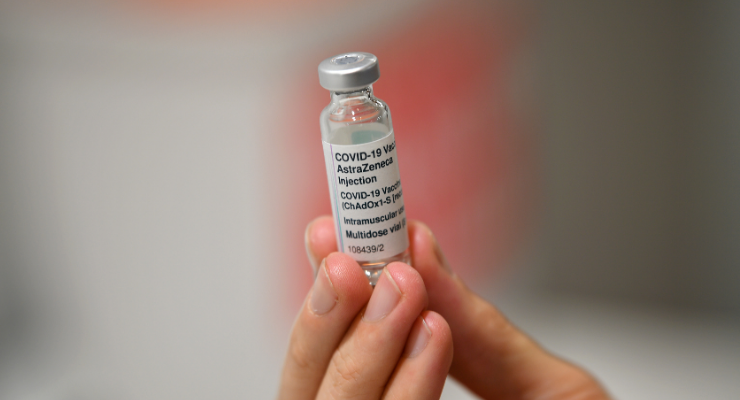
“I’m not getting the vaccine yet. I think I’ll just hang back and wait for one that’s better than what we have.” Doctor, 60
“I’m no anti-vaxxer, but these blood clots have got me thinking. Do I really need it?” Public relations consultant, mother of one, 53
“I’m fit and healthy. I reckon I’ll let others go ahead of me on this one.’’ Businesswoman, board member and mother of two, 54.
“We’ve got so much stock. I don’t know why, all of a sudden, people aren’t lining up.” GP receptionist, 30-something.
Those comments were delivered over the weekend as anti-vax rallies played out across the nation. And they might point to middle Australia being a much bigger obstacle to the vaccine rollout than a bunch of ignorant attention-seekers yelling down a microphone.
It’s become relatively easy to dismiss anti-vaxxers. Their ignorance is on display: “The vaccine actually gives you the virus”; “There’s a 5G chip hidden inside the vaccine.” Their unwillingness to look at history stands out, too — they blatantly disregard the role vaccines have played in killing off smallpox, polio and dozens of other diseases, such as cervical cancer.
While limited in knowledge, they can attract millions of supporters, including celebrities, as can be seen on the anti-vax social media pages. But their voices have become a bit like old, tired wallpaper, and that’s allowed us to put them in a box. ANTI-VAXXER. DO NOT OPEN. DO NOT LISTEN.
What’s more dangerous is what appears to be a growing reluctance to be vaccinated by middle Australia. Mums and dads. Businessmen and women. Elderly people who rely on their children for advice.
That’s been driven by a couple of factors. Ironically, Australia’s strong position in not allowing COVID-19 a stranglehold has meant that we feel safe. “But do we really need it?” a friend asked me yesterday. She’s strongly pro-vaccine and her children have all been vaccinated. “I’m not sure any more.”
She’s not alone. An Australian National University study published in February found there had been “a substantial increase in vaccine resistance hesitancy and a large decline in vaccine likeliness between August 2020 and January 2021″.
Indeed, the figure jumped from 12.7% to 21.7%. Worryingly, the biggest change was in those who went from being “definitely willing” to be vaccinated to only “probably willing” to get one. That’s worsened since February. Then people wanting the vaccine were lining up at GPs demanding it. Yesterday at one vaccine clinic the room was empty. That stock will go to waste.
Risk barometer
The potential for this to worsen is real because those now doubting it are sensible, reasonable people. They’ve seen the tiny number of blood clots. They’ve heard of slightly more cases of anaphylaxis. And their risk barometer is telling them that this vaccine now is not urgent. “I’ve told mum she doesn’t need to get it just yet; we might wait and see,” another friend said.
Fear of the virus drove many to demand a vaccine. Now fear of the vaccine risks driving many away. That type of thinking — which is being ignored in all the messaging — is a serious problem for our governments relying on a big vaccine rollout to open borders and businesses.
It’s also a problem if the pandemic takes hold, and India — which originally escaped the catastrophe we are now seeing — is a salutary lesson.
How does the government change it? The message is now as important as the jab. Forget the anti-vaxxers and the trolls. Forget banning the odd Facebook page or ignoring those chanting “it’s my body” down the main streets of our cities.
This battle needs to be won in electorates held by Labor and Liberal; in cities and rural areas; among the old and the young. If that requires incentivising voters, then that should be on the table too, because poor vaccination rates will add more than a headache to the nation’s plans to fight COVID.








Faced with the choice of suffocating to death or a vaccine, the vaccine is for me. We are a couple of bad choice away from a very serious situation with a federal government that cannot or will not take action without the states leading the way.
The vaccination stroll out is despicable and National Quarantine facilities are a joke.
Voters will remember.
This was always going to be a problem once the perception had developed that the Pfizer vaccine was superior to AZ and was banned to anyone over 50. The government needed to be on the front foot with a communications campaign to counteract this. As we know they outsourced the communications to a private provider instead of relying on existing in house expertise with the predictable result that their communications strategy has been as inept as their delivery.
Look at the leasership of PM Morrison and his CMO – both publicly vaxxed with Phizer while too old to be eligible.
All the risk focus is on rare clotting side effect but much more pervasive effects exist with astrzenneca – persistent snd bad headaches well documented in UK and are evident here now. Lets not brush the meningeal effects under the carpet
““We’ve got so much stock. I don’t know why, all of a sudden, people aren’t lining up.” GP receptionist, 30-something.”
There is an answer to that one. At first GP’s offices were receiving only 50 doses per week which was insufficient for phases 1a and 1b patients. The dose levels then seemed to increase but patients were not aware of this.
My GP’s office notified me by sms that the regular flu shots were available. When I phoned (and waited ages to get through) to make an appointment I asked about Covid supplies and book the flu shot and the Covid vaccine 16 days apart.
For me Covid shots are a no-brainer as I am old enough to remember kids at school who had had polio and wore callipers for the rest of their much shortened lives.
My gp still has no stock- very large practice in sourhern higjlands.
Agree re ignoring the anti-vaxxers, on all evidence, including in Cam Wilson’s article today, they are around 2% of the population and at the not very good at thinking but credulous end of the spectrum. Their numbers are about normal for whakos on similar issues.
In relation to broader vaccine hesitancy I would note having apparent choice, no matter how curtailed at present, creates a hesitant contemplation for a section of the population. Even more choice, here comes Moderna, will amplify it further for some.
In regard to AZ I think there is a paradox operating between public health thinking and individual thinking. At a public health population level, chances of a side effect are very very low and the benefits the vaccine confers for everyone, including all those who have a relatively untroubled experience of it, are very high. For an individual the point may be that if I get the serious side effect it doesn’t matter that everyone else is fine, I am not. And given that there were reports from overseas that the mortality rate for those who got the clot was 25%, one in four, that, if true, is a serious side effect.
So it’s not an illogical worry, especially when one might hope for a vaccine in the near future that doesn’t carry that risk. That said, while I and many friends did entertain this thinking we went ahead and got vaxxed. I bought a lotto ticket the same day. I’m still here, but no richer.
“For an individual the point may be that if I get the serious side effect it doesn’t matter that everyone else is fine, I am not. And given that there were reports from overseas that the mortality rate for those who got the clot was 25%, one in four, that, if true, is a serious side effect.”
What’s missing from that is the likelihood of the side effect. 25% *if* you get the side effect sounds big, but if the side effect is vanishingly rare then 25% of an incredibly small risk is an incredibly small risk.
As they are saying at the moment, the risk of dying from the vaccine is about 1 in 1,000,000. Meanwhile the risk of dying from anaesthesia is about 1 in 100,000 for a healthy person (assuming the number is higher if medical conditions are factored in).
So even if the numbers are higher than reported, focusing on the severity of the side effect isn’t that useful. The relative risk is higher, but the absolute risk is effectively non-existent.
Thank you for that, I agree and it is important to lay out just how tiny the risk is. I was suggesting the thinking behind some hesitancy, not to endorse it. Unfortunately not everyone is comfortably at home in using mathmatical probability. Imagination allows millions to buy lotto tickets despite the chances of winning the jackpot being far far worse than 1 in a million, more like 1 in 45 million.
Agreed, and even if it’s one in a million people will feel it as far more likely than that. Even something tangible like 1 in 100 is seen as way more likely than it is.
I suppose this is the limitation of reporting. Imagine the number of stories the media would need to publish of people not having a side effect to give a representative sample compared with the number of stories about a side effect. We were given reminders of the worst case scenario on a near daily basis, so how are people meant to intuitively engage in risk assessment?
The utter incompetence of the Morrison Government purports to prove that the vaccine is not important.